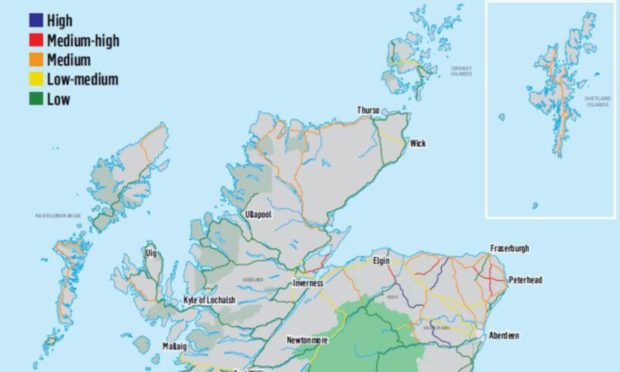Three of the UK’s 20 most dangerous rural roads for young drivers can be found in the north-east and Moray, according to new research conducted by the AA.
The AA Charitable Trust looked at more than 70,000 young drivers between the ages of 17 and 24 who had been involved in crashes across the UK on country roads from 2013 to 2018.
The team behind the study created an interactive map of the results, showing the relative risk of collision for young drivers on rural roads all throughout England, Wales and Scotland.
Most dangerous routes for young motorists
The worst road found for the percentage of all crashes, or relative risk, was recorded in County Durham.
But the 12th worst under these criteria across the UK was the A980, Banchory to Alford road, where 27 collisions were noted during the recording period.
Of those, 13 involved young drivers.
At number 13 on the list was the A97, between Banff and Huntly, with 25 recorded crashes. Twelve of the incidents involved motorists aged 17 to 24.
The A941, Rhynie to Craigellachie road, was number 14 on the list with 13 collisions. Six of them involved younger motorists.
Time, date and location among factors investigated
The AA study, funded by the Road Safety Trust, also includes locations of all fatal incidents, as well as those involving serious or slight injuries.
It analysed the time and days of crashes and found the proportion of collisions on rural roads on Sundays is 24% higher for younger drivers than it is for other ages of motorists.
Top 20 list features three roads in north of Scotland
The below list outlines the percentage of crashes which involved young drivers, indicating the crash risk relative to that of other drivers.
- A6076 in County Durham
- A704 in West Lothian
- A419 in Gloucestershire
- A388 in Cornwal
- lA41 in Hertfordshire
- A846 in Argyll and Bute
- A5093 in Cumbria
- A885 in Argyll and Bute
- A4068 in Powys
- A436 in Gloucestershire
- A714 in Dumfries and Galloway
- A980 in Aberdeenshire
- A97 in Aberdeenshire
- A941 in Moray
- A594 in Cumbria
- A698 in Scottish Borders
- A5117 in West Cheshire (HE)
- A495 in Wrexham
- A1122 in Norfolk
- A4113 in Powys
‘71% of fatal car crashes involving young drivers take place on rural roads’
Edmund King, director of the AA Charitable Trust, said: “This groundbreaking analysis shows, for the first time, the most dangerous rural roads for young drivers as well as an in-depth study of contributory factors involved in those crashes.
“Many young drivers and indeed parents are unaware that rural roads pose a specific and significant risk to young drivers and potentially are much more dangerous than motorways or urban roads.
“71% of fatal car crashes involving young drivers take place on rural roads.
“The research should help target driver education at the times and places young drivers are most at risk.
“Our data clearly shows that the rural road risk is highest for the youngest drivers on our roads and decreases with each year of age.
“This is a clear sign greater education and exposure to rural roads helps alleviate the risks they pose.
“This is just the first stage in what we plan to be an ongoing campaign to really improve the education of young drivers on rural roads.”
